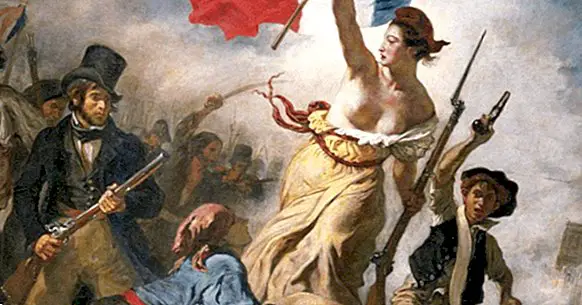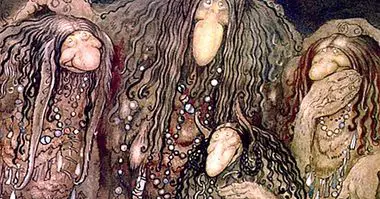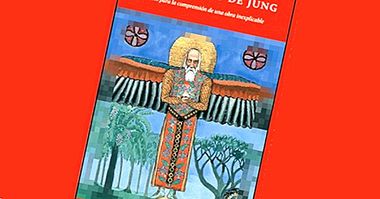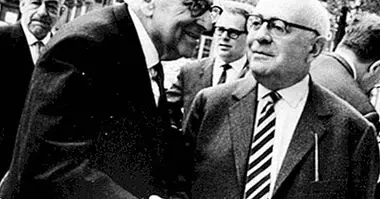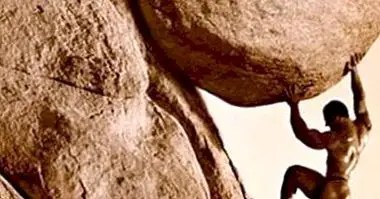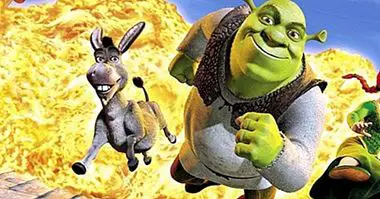The 5 ages of History (and its characteristics)
The human being has been making his mark in the world for millions of years. Through the ages we have learned a lot: among many other things we have developed agriculture and livestock, art and technology, faith, philosophy and science, civilization and culture. Countless peoples, civilizations, empires and systems have been born and disappeared, while many others have evolved to become what they are today. The whole set of events that occurred over time of which we have evidence is what we consider history.
But history is not totally uniform: we can distinguish specific time periods within it in which different advances or major changes have taken place. Is about the different ages of history .
- Related article: "History of Psychology: authors and main theories"
The ages of history
We consider history to set of events and events that humanity in general has lived through time that it takes on the Earth, since the writing was invented as a method of symbolic registration that allows us the analysis and knowledge of what happened in the past. Although technically before this the human being had already suffered great tribulations and had developed multiple skills, knowledge and techniques, the fact of not being able to know the concrete events that they lived makes that the pre-writing period is considered as outside the history .
Since the invention of writing There are innumerable facts and events that have marked the evolution of history and have changed our world to a great extent. History is broad, and historians have divided it into various ages to facilitate its understanding by identifying great moments of change.
There are four great ages in which historians (since Christopher Cellarius introduced them) tend to divide history, although within them some subdivisions can be found. In assessing the development of the human being, however, we also usually add the previous era to what we know as history: prehistory. However, keep in mind that these historical stages are separated from each other mainly on the basis of the events that occurred in Europe . Once this has been clarified, it is worth mentioning that the main ages of the story are the following.
1. Prehistory
As we have said, this stage would not really be part of the story because it includes the set of events prior to the invention of writing. But it is a period of great advances, being in fact the longest stage that humanity has lived . The appearance of Homo sapiens, the emergence of oral language, the discovery of fire, the creation of the first tools and of the first fixed villages or the passage of hunters / gatherers to farmers / ranchers happened at this time.
This stage is subdivided into Stone Age (which in turn is divided into Paleolithic, Mesolithic and Neolithic) and Age of Metals (divided into Copper, Bronze and Iron, although many of the events of this last period already belong to the history).
- Related article: "The 6 stages of Prehistory"
2. Ancient Age
The first of the ages of history, the Ancient Age begins with the invention of writing (roughly considered to have arisen between 3500 and 3000 BC). The Ancient Age would then begin at a time between the aforementioned ages of Bronze and Iron. Its completion is approximately in 476 AD, with the fall of the Western Roman Empire.
This stage is characterized as being the longest in history, and part of the events that occurred in it have been lost. It is in the Ancient Age in which the human being it abandons mostly nomadism and becomes sedentary , being this age the moment in which great civilizations arose like the Greek, the Egyptian, the mesopotámica, the Persian and the Roman. This stage is also famous for the high prevalence of battles and wars, slavery and the emergence of various systems and political concepts such as democracy or dictatorship.
At a European level, the presence of a large number of peoples and traditions that little by little were invaded and were lost as they were agglutinated by the Roman Empire, which spread through Europe and part of Asia and Africa.
On the other hand, this stage of the story is one in which there were great advances in the knowledge of the human being , being the period in which the classical stage of philosophy appears (from which all sciences will later split). Different belief systems and values were generated. At the level of religion, different cultures maintained beliefs in general polytheists.Also in her they arose some of the main current religious beliefs so much politeístas (like the hinduismo), like monotheistic (the Judaism and the Christianity).
Within the Ancient Age two stages can be distinguished: classical antiquity and late antiquity.
Classical antiquity
Classical antiquity is the period characterized by the expansion of the Greek and Roman civilizations , technically from the fifth century to the second before Christ. In this stage we observe the emergence of both civilizations, the Great Alexander Empire, the medical wars, the emergence of democracy, the Roman Republic and its expansion through Italy, the creation and expansion of the Roman Empire and the beginning of its decline.
Late Antiquity
Late antiquity would go from the second century BC to 476 AD, corresponding to the decline of the Roman Empire and the transition from slavery to feudalism . In this stage Rome and its empire begin to suffer increasingly frequent uprisings (highlights the starring Spartacus) and is invaded by the Germanic peoples (as happened in the Iberian Peninsula).
One of the best-known invasions was that of Attila the Hun . Also relevant is the appearance and expansion of Christianity as the official religion of the Empire, which later became the dominant religion in European territory. Late antiquity would technically end in 476 AD, with the fall of the Roman Empire.
3. Middle Ages
This etpa is curiously linked to the destiny of the Roman Empire, since it originates with the fall of the Western Roman Empire (in 476 AD and ends with the fall at the hands of the Ottomans of the Byzantine Empire (the Eastern Roman Empire) in 1453. However, other historians consider that its completion corresponds rather with the arrival of Columbus to America in 1492.
After the fall of the Roman Empire, which centralized power, different kingdoms and civilizations emerged, establishing different peoples and nations. Feudalism appears as a political system, in which the lords ruled their lands a la par obeyed the figure of the king . During this stage the expansion and dominance of Christianity as the predominant religion of Europe was observed, and Islam is also born in Arabia as a religion.
Also, it is during this time that the bourgeoisie appears as a social class. There are frequent war conflicts framed or justified by religious differences, being the time of the Crusades and of different religious persecutions . Different groups and sects appear, many of which are considered heresies and eliminated. There is also the figure of the Inquisition, the acts of faith and the burning of witches.
This historical period can be divided into two stages: High Middle Ages and Low Middle Ages. Although sometimes an intermediate stage is added, the Feudal Age.
High Middle Ages
It is considered High Average Age to the period of time that passes between centuries V and X. It supposes a period of time in which different empires and civilizations fought among themselves, once the Roman Empire fell. Vikings, Hungarians, Muslims, Byzantines and the Carolingian Empire They were some of the most relevant at European level.
The population lived mostly in the countryside, and was divided into nobles and commoners. The class differences are very evident, with the nobility all the rights and the commoners practically none. Feudalism arises and there are constant wars arising from the control of lands and manors. The culture is very mediated by the Church and the Inquisition arises.
Middle Ages
The final stage of the Middle Ages, the Late Middle Ages corresponds to the period of time between the eleventh century and the fall of Constantinople to Turkish hands in 1453 (or the discovery of America in 1492, depending on where the limit is placed ).
This stage supposes a general economic resurgence, appearing the bourgeoisie and beginning the population to center in the cities. The number of wars decreases and the population begins to increase. The mill is invented and begin to appear the first rights for peasants and bourgeois , working the latter in exchange for remuneration and not for servitude. During the fourteenth century feudalism falls into decay and dissolves. The power of the Church also diminishes, although it still has great influence.
Another great event of great importance is the emergence of the epidemic of the Black Death, the largest epidemic that has been recorded and that ended the life of around one third to one half of the population of the time.
4. Modern Age
The fall of Constantinople in 1453 or the arrival of Columbus in America in 1492 are the two main starting points of the so-called Modern Age. The end of this age is placed in 1789, concretely the day of the taking of Bastille that gives beginning to the French Revolution.
During this stage appears absolutism, in which the kings concentrated political power . The end of this form of government would also lead to the end of the Modern Age, with the French Revolution.Other events of great relevance were the cited discovery of America (and its subsequent invasion) and its colonization by various countries. Expansionism abounds, in a stage marked by the colonization of what are considered new territories. However, with the passing of the centuries, uprisings that culminate with the American Revolution and the War of the Independence of the United States and multiple colonies are produced. Slavery is abolished.
Culturally, highlights the rise of the Enlightenment , a cultural movement that transformed the intellectual life of the time: God let be the nucleus of intellectual interest to focus on the figure of the human being. It was a time when there were great scientific and social advances, coming to appear the steam engine or the first vaccines. There were also political and religious changes, as well as major conflicts linked to these changes, such as those produced based on the Lutheran reform and the counter-reform. Also, it was during this time that the Spanish Golden Age passed, with the Spanish Empire being one of the most powerful of the time.
The completion of this stage occurs with the French Revolution , a historical milestone of great importance in which absolutism was abolished. This stage and its end are characterized by the appearance and subsequent persistence of the values of Western society.
5. Contemporary Age
The last of the ages contemplated in the story, includes all the events that took place from the French Revolution to the present. There are many known milestones of this stage. The French Revolution itself, the advance of technology to reach the so-called Industrial Revolution, the First World War, the emergence of fascism and the Second World War are some of the best known events.
In addition to this we can observe the evolution of the rights, duties and freedoms of citizens and of the different social groups. The struggle for the eradication of social classes, for the rights and equality of women, of different races and sexual orientations are other milestones that have been achieved or are in the process of being achieved during this stage.
There is still a great social inequality, although the traditional social classes lose part of their validity: the power begins to be shared between aristocracy and bourgeoisie. The bourgeoisie is established as the predominant class and the middle class appears. However, it still exists (even today) social classism, although this time it is more linked to economic capacity and not the social stratum of birth.
Appear the great economic systems still in force, capitalism and communism, which come to face in many historical moments as during the Cold War.
Also science has evolved greatly , improving the living conditions of most of the western population. Medicine advances to make previously deadly diseases can be controlled and even eradicated, although new diseases (such as AIDS) are discovered or reconceptualized. Man engages in the exploration of space, reaching the Moon and seeking to go beyond she. Recently appeared computer science, and over time internet (some authors opining that this milestone could be considered a change to another new age).

